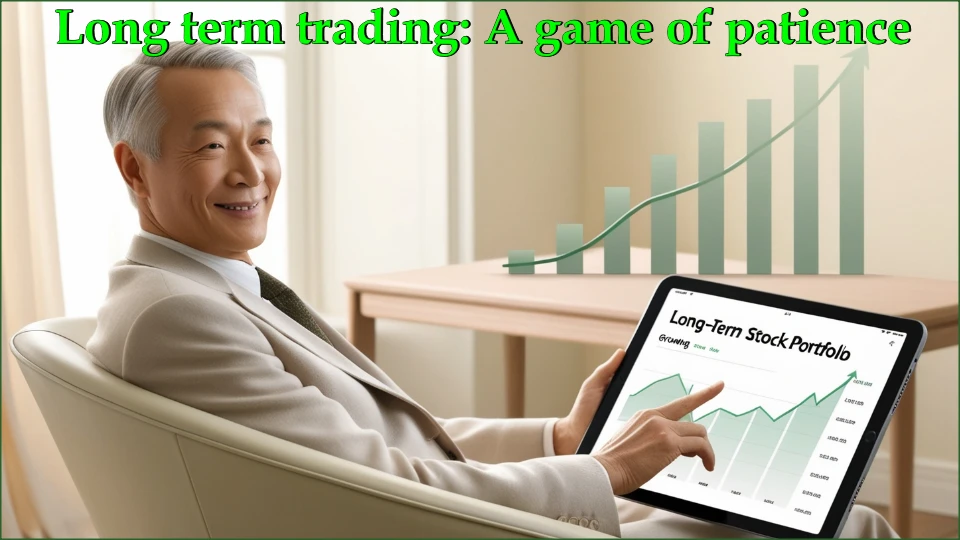Stepping into the world of the stock market can be exciting for many, but it is equally important to understand all the information and processes associated with it.
Whether you are a new investor or an experienced trader, it is very important to understand the various methods like intraday trading, long term investment and swing trading to succeed in the stock market. Along with this, tax rates on the gains made in the stock market and managing them properly is also a major part.
In this article, we will understand in detail the difference between intraday and long term trading, tax-related information, risk factors, and tips for investors.
Intraday trading: What is it and how does it work?

Intraday trading simply means that the stock you buy in the morning is sold before the market closes on the same day. This method is mainly for those who want to make fast profits in the stock market. Intraday trading requires very fast decisions, as the whole game depends on the fluctuations of the stock prices within a day.
For example, the Indian stock market opens at 9:15 am and closes at 3:30 pm. If you have bought a stock under intraday trading, you have to sell it before 3:30 pm. If you don’t do this, then around 3:20 pm this stock will be sold by your broker, or it will be converted into a “delivery share”. This means that now that stock will be kept in your portfolio for the long term.
Key aspects of intraday trading
Fast profits: The biggest advantage of intraday trading is that you can make good profits within a few hours. But it is also important that you keep a close eye on your investment and decide to sell the stock at the right time.
Risk factor: The risk in intraday trading is also very high. Stock prices can fluctuate rapidly, and if you are unable to sell the stock at the right time, you may suffer a loss.
Technical analysis: People doing intraday trading mainly depend on technical analysis. Charts and graphs are used to understand in which direction the stock prices will move.
Advantages and disadvantages of intraday trading
Intraday trading is for those who want to take advantage of small movements in the stock market. Its biggest advantage is that if you buy and sell at the right time, you can make fast profits. But its flip side is that if you accidentally sell shares at the wrong time, you may have to suffer losses.
For intraday trading, you have to keep a close eye on the trends and movements of the stock market. This is an area that not only requires patience but also deep understanding.
Long term trading: A game of patience

Long term trading is considered to be the most stable and safe way of investing in the stock market. In this, you buy shares of a company and hold it for a long time (usually more than a year). In long term trading, you have to pay attention to the fundamentals of the company. Such as the company’s balance sheet, market value, management, and what will be the future demand for the company’s products.
Key aspects of long term trading
Visionary investment: In long term trading, you invest keeping in mind the future of the company. You expect that the company’s performance will be good in the coming years and the share price will increase.
Fundamental analysis: In long term trading, the focus is on the fundamentals of the company instead of technical analysis. In this, the company’s financial position, its competition in the market, and future plans are studied in depth.
Need for patience: In long term trading, you have to be patient. There will be fluctuations in the share prices, but you have to have faith in your investment. Even if the market is down, you can buy more shares instead of selling them.
Benefits of long term trading
The biggest advantage of long term trading is that it has less risk. If you have invested in the right company, then its value is likely to increase over time. Apart from this, you also get more tax exemption in long term investment.
Long term trading vs. Intraday trading: Which is better?
- This question has always been there among investors that which is better between intraday trading and long term trading. The answer depends on what type of investor you are and what is your investment goal.
- Intraday trading is better for those who want to make quick profits and can keep a constant eye on market movements.
- Long term trading is better for those who want to invest with patience and understand the fundamentals of the company.
Taxation: How is tax levied on intraday and long term trading?
Paying tax on profits after investing in the stock market is an important aspect. Tax rates depend on the type of your investment and its holding period. If you are a stock market investor, then it is very important for you that you should also know tax related information.
Tax on intraday trading
If you do intraday trading, then 30% tax will be levied on the profits you earn. This is a kind of trading income tax, because you buy and sell shares in a very short time and make a profit. This tax is levied on your total trading income at the end of the year.
Short term capital gain tax
If you hold a stock for less than a year and sell it, then you will have to pay short term capital gain tax. A tax of 20% is levied on it by the government. This rate of short term capital gain tax was earlier 15%, but the Government of India has increased it to 20% in the budget of 2024-25.
This tax means that if you held the stock of a company for less than a year and made a profit by selling it, then you will have to pay 20% tax on that profit. This rate is applicable for those who invest for the purpose of short-term profits.
Understand long term capital gain tax
If you have held the shares of a company for more than a year and then made a profit by selling it, then long term capital gain tax is levied on it.
In the budget of 2024-25, the rate of this tax has been increased to 12.5%, which was 10% earlier. This means that if you held a stock for a long time and sold it after its price increased, then this tax will be applicable on your profit.
But the thing to note is that if you have made a profit of up to Rs 1,25,000, then no tax will be levied on you. Earlier this limit was Rs 1 lakh, but in the new budget it has been increased to Rs 1,25,000. This benefits small investors, who make small investments in the beginning and gradually make profits.
Do you know how much tax planning is required
Investors of both intraday trading and long term trading should plan for tax. In intraday trading, there is an opportunity to earn quick profits, but it is also taxed at a high rate. On the other hand, long term investment has less tax, but it takes time to get profits.
If you do tax planning correctly, you can reduce the tax burden. For example, if you make long term investments, you can hold your investments for more than a year to take advantage of the low tax rate.
On the other hand, in intraday trading, you can keep a part of your profits aside to pay taxes so that you do not have trouble at the end of the year.
Risks of intraday trading vs long term trading

Before investing in the stock market, it is important to understand that every type of investment has a balance of risk and reward. The more risk you take, the greater the possibility of profit. But this also means that the risk of loss will be equally high.
Risk in intraday trading
The risk in intraday trading is very high, as it is based on the day-to-day fluctuations of stock prices. Stock prices can change in a matter of hours, and if you do not make a decision at the right time, you may suffer huge losses.
Apart from this, technical analysis plays a very important role in intraday trading. If you do not analyze the charts and graphs correctly, your investment may go in the wrong direction.
It is also worth noting that for intraday trading you have to keep an eye on the market every day, which can be quite time-consuming and mentally exhausting.
Risk in long term trading
The amount of risk in long term trading is less, as you study the fundamentals of the company and understand the financial position of the company thoroughly before investing. If you have chosen the right company and it has a bright future, then your capital will increase over time.
However, risk is not completely eliminated even in long term investment. If you invest in the wrong company, or there are sudden big changes in the market, the value of your investment may fall.
But, in long term trading you are patient, and even when the market is down, instead of selling shares, you can buy more shares, which can increase your total investment.
Intraday or Long term trading: Which method is right for you?
Now the question arises whether intraday trading is better or long term trading? The answer depends on your investment goals and your financial situation. Let’s understand this in detail.
Do you want to make quick profits?
If your goal is to make quick profits and you can keep a close eye on the fluctuations of the stock market, then intraday trading can be the right option for you. But for this you should have complete knowledge of the market, and you should also be an expert in technical analysis.
Do you want to make long term investments with patience?
If you are patient in terms of investment and want to earn good profits in the long term, then long term trading is better for you.
There is less risk in this, and tax is also levied at a low rate. But for this you have to understand the fundamentals of the company well and have faith in its future.
Swing Trading: The way between intraday and long term trading
Now let’s talk about swing trading, which is a different way of investing. This is the way between intraday and long term trading, where you hold the stock for a few days to a few weeks. The main objective of swing trading is to take advantage of the mid-term movements of stock prices.
Key aspects of swing trading
Medium-term investment: In swing trading, you hold the stock for more than a day but less than a month. Its main objective is to take advantage of the fluctuations in prices.
Technical and fundamental analysis: In swing trading, along with technical analysis, the fundamentals of the company are also studied. This helps in understanding how the company will perform in the future.
Low risk, good profit: There is less risk in swing trading as compared to intraday trading, because you have time for the stock prices to improve.
Benefits of swing trading
The advantage of swing trading is that you do not need to take immediate decisions like in intraday. You have time to see the changes in the stock prices and take decisions accordingly. Apart from this, the possibility of profit is also higher in swing trading, because you hold the stock for some time.
Tips to succeed in the stock market
To succeed in the stock market, it is not enough to know only the right information and ways of investment. You should also pay attention to some other important tips, which can help you in your success.
Before investing, it is important to gain complete knowledge
Investing in the stock market without any information can be very risky. Whether you do intraday trading or long term trading, every time before investing, do a thorough study of that company. Understand the balance sheet of the company, its products and future plans. This will help you take the right decision.
It is very important to have patience in the world of stock market
Patience is very important in the stock market. There will be ups and downs in the market, but you do not need to panic. If you have invested in the right company, its value will increase with time. So have faith in your investment and do not sell it in a hurry.
Keep your investments diversified
Investing all the money in a single company or sector can be very risky. Always keep your investments diversified. Invest in different sectors and companies, so that even if there is a loss in one company, your entire portfolio is not affected.
You must review your portfolio regularly
To be successful in the stock market, it is important that you review your portfolio regularly. If the performance of a company is not as expected, then make changes in it in time. On the other hand, if the performance of a company is improving, then consider investing more in it.
One should not miss out on earning profits at the right time
Many times it happens that we are not able to book profits at the right time due to long term trading. So understand when it would be right to book profits. If you feel that the performance of a company is at its peak, then it may be right to book profits.
How will you create your portfolio in the stock market?
To invest in the stock market, first you have to create your portfolio. Portfolio is the place where you keep all your investments in one place and manage them.
How should you set your financial goals?
First of all, decide for what purpose you are investing. Do you want to make quick profits, or are you investing for the long term? Your financial goals should be based on your portfolio.
Conclusion
The stock market offers various ways to invest, such as intraday trading, long term trading, and swing trading. Each method has its own benefits and risks.
The difference between intraday and long term trading is very clear such as intraday trading is for those looking for quick profits but involves higher risk while long term trading requires patience and is more stable, with lower taxes.
Swing trading is a balanced option between the two, where you hold stocks for a few days or weeks. Understanding your investment goals, doing thorough research, and managing risks are key to success in the stock market.
Read Also: How to invest in index funds for beginners?
Read Other Latest Posts Below







